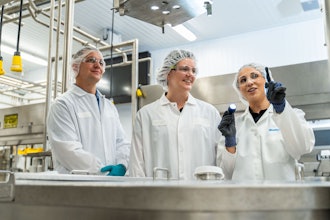Drones Explore Caves
Last week, ESA astronauts traveled to an underground system of the Sa Grutta caves in Italy for a two-week course they call CAVES, which stands for Cooperative Adventure for Valuing and Exercising human behavior and performance Skills. Essentially, it's an intense team building exercise.
Deep within the caves, the team tested a new type of drone that is built to withstand collisions. It's called the Elios from Flyability, and it's a drone tucked safely into the center of a carbon fiber shell which allows it to fly in and chart confined spaces.
The drone was equipped with infrared and optical cameras, and was launched into a 100 m-high vertical tunnel. Two pilots, one working the cameras and the other flying the drone, searched the tunnel for hot spots and mapped areas of the cave that have never been seen before.
The drone performed nine flights inside the dark abyss without crashing, even though the air currents formed enough condensation to make it seem like it was continuously raining inside the shaft.
The test flights were a part of an ESA strategy that sees humans and robots working more closely together to explore and build settlements on planetary bodies, and it looks like Elios might play a significant role, particularly once it can operate autonomously.
3D-Printed Grenade Launcher
Last week, RAMBO made another appearance. Thankfully, it wasn't a new installment in the long-bloated movie franchise, but rather another look at the proof-of-concept Rapid Additively Manufactured Ballistics Ordnance (RAMBO) that made news earlier this year.
The grenade launcher, which was made at the Armament Research Development and Engineering Center (ARDEC) at Picatinny Arsenal in New Jersey, was on display at the Department of Defense-sponsored "Lab Day" at the Pentagon.
According to the Army News Service, a 3D printed grenade launcher shouldn't be the headline. Rather, the focus should be the ability to 3D print replacement parts for soldiers while they are on the battlefield.
Soldiers could soon see the Army's Rapid Fabrication via Additive Manufacturing on the Battlefield (RFAB) in the field. The RFAB is a portable facility with a bunch of different commercial 3D printing technologies that will be used to manufacture parts as they are needed to replace broken gear.
In August, RFAB will be upgraded with "Raptor," a software catalog that includes CAD files for 500 of the most frequently-broken parts. A bit further into the future, soldiers will able to use the 3D printers to customize their own weapons.
DARPA Picks Boeing to Design Experimental Spaceplane
Boeing and DARPA are going to design, build and fly an experimental vehicle that they hope will provide aircraft-like access to space. The vehicle is a part of the Experimental Spaceplane (XS-1) program. They call the craft the Phantom Express, likely because it's coming out of Boeing Phantom Works, the advanced prototyping arm of the Defense and Security side of The Boeing Company.
Boeing will now begin work on the autonomous, and (more importantly) reusable, spaceplane that should be about the size of a business jet. The craft will take off vertically, and be capable of launching small satellites (about 3,000 pounds) into low Earth orbit. It would then return to earth where it would land on a runway to be prepared for its next flight.
The idea is that it would be serviced much like a Delta flight trying to make a quick turnaround in Detroit. The hope is that they can do it for $5 million, or less, per launch, a fraction of the cost of current military launch systems.
The spaceplane will be powered by an Aerojet Rocketdyne AR-22 engine, a version of the legacy Space Shuttle main engine, and use liquid oxygen and liquid hydrogen fuel. It will also feature:
- Advanced, lightweight composite cryogenic propellant tanks to hold liquid oxygen and liquid hydrogen propellants
- Hybrid composite-metallic wings and control surfaces able to withstand the physical stresses of suborbital hypersonic flight and temperatures of more than 2,000°F
- Automated flight-termination and other technologies for autonomous flight and operations, including some developed by DARPA’s Airborne Launch Assist Space Access (ALASA) program
To prove the concept, and the viability of the quick turnaround, Boeing and DARPA plan to conduct a demonstration of 10 flights over 10 days with the final flight delivering an actual payload. But that’s not until 2019, and it will be interesting to see how far SpaceX advances their autonomous rockets over the next two years.
This is Engineering By Design with David Mantey.



















